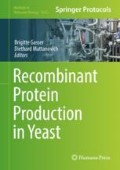Abstract
Since the introduction of the yeast display platform, this method has increasingly gained popularity for the discovery and affinity maturation of antibodies and other protein scaffolds intended for antigen recognition. Yeast display is particularly well suited for the selection of antigen-binding Fc fragments (Fcabs) as it allows rapid combinatorial library construction via gap repair-driven homologous recombination and an efficient display of a glycosylated Fc able to interact with Fcγ receptors. Apart from expression-related normalization, isolation of properly folded Fcabs can be guided efficiently by simultaneous staining with ligands such as protein A, FcγRI, or the conformation-sensitive anti-FigCH2 antibody, whose binding is critically dependent on the integrity of the Fc structure. The particular properties of the Fcab scaffold, such as its homodimeric state which can promote binding to multiple antigen molecules, require modifications of traditional affinity maturation strategies. Preferred to equilibrium selections are kinetically driven antigen selections, designed to specifically influence the binding off-rate, which in many cases augments the desired biological effect. A simple design of a yeast-displayed heterodimeric Fc fragment is described and can be used as a general guideline for affinity selection of Fcabs with an asymmetric binding site. Overall, this chapter underlines the importance of the versatile yeast display technique for the optimization of the novel Fcab scaffold for antigen recognition.
Access this chapter
Tax calculation will be finalised at checkout
Purchases are for personal use only
References
Wozniak-Knopp G, Bartl S, Bauer A et al (2010) Introducing antigen-binding sites in structural loops of immunoglobulin constant domains: Fc fragments with engineered HER2/neu-binding sites and antibody properties. Protein Eng Des Sel 23(4):289–297. https://doi.org/10.1093/protein/gzq005
Leung KM, Batey S, Rowlands R et al (2015) A HER2-specific modified Fc fragment (Fcab) induces antitumor effects through degradation of HER2 and apoptosis. Mol Ther 23(11):1722–1733. https://doi.org/10.1038/mt.2015.127
Hasenhindl C, Traxlmayr MW, Wozniak-Knopp G et al (2013) Stability assessment on a library scale: a rapid method for the evaluation of the commutability and insertion of residues in C-terminal loops of the CH3 domains of IgG1-Fc. Protein Eng Des Sel 26(10):675–682. https://doi.org/10.1093/protein/gzt041
Boder ET, Wittrup KD (1997) Yeast surface display for screening combinatorial polypeptide libraries. Nat Biotechnol 15(6):553–557. https://doi.org/10.1038/nbt0697-553
Traxlmayr MW, Lobner E, Antes B et al (2013) Directed evolution of Her2/neu-binding IgG1-Fc for improved stability and resistance to aggregation by using yeast surface display. Protein Eng Des Sel 26(4):255–265. https://doi.org/10.1093/protein/gzs102
Traxlmayr MW, Lobner E, Hasenhindl C et al (2014) Construction of pH-sensitive Her2-binding IgG1-Fc by directed evolution. Biotechnol J 9(8):1013–1022. https://doi.org/10.1002/biot.201300483
Poulsen TR, Jensen A, Haurum JS et al (2011) Limits for antibody affinity maturation and repertoire diversification in hypervaccinated humans. J Immunol 187(8):4229–4235. https://doi.org/10.4049/jimmunol.1000928
Chames P, Van Regenmortel M, Weiss E et al (2009) Therapeutic antibodies: successes, limitations and hopes for the future. Br J Pharmacol 157(2):220–233. https://doi.org/10.1111/j.1476-5381.2009.00190.x
Schier R, Balint RF, McCall A et al (1996) Identification of functional and structural amino-acid residues by parsimonious mutagenesis. Gene 169(2):147–155
Chen Y, Wiesmann C, Fuh G et al (1999) Selection and analysis of an optimized anti-VEGF antibody: crystal structure of an affinity-matured Fab in complex with antigen. J Mol Biol 293(4):865–881. https://doi.org/10.1006/jmbi.1999.3192
Razai A, Garcia-Rodriguez C, Lou J et al (2005) Molecular evolution of antibody affinity for sensitive detection of botulinum neurotoxin type A. J Mol Biol 351(1):158–169. https://doi.org/10.1016/j.jmb.2005.06.003
Chao G, Lau WL, Hackel BJ et al (2006) Isolating and engineering human antibodies using yeast surface display. Nat Protoc 1(2):755–768. https://doi.org/10.1038/nprot.2006.94
Shusta EV, Holler PD, Kieke MC et al (2000) Directed evolution of a stable scaffold for T-cell receptor engineering. Nat Biotechnol 18(7):754–759. https://doi.org/10.1038/77325
Traxlmayr MW, Faissner M, Stadlmayr G et al (2012) Directed evolution of stabilized IgG1-Fc scaffolds by application of strong heat shock to libraries displayed on yeast. Biochim Biophys Acta 1824(4):542–549. https://doi.org/10.1016/j.bbapap.2012.01.006
Takechi Y, Yoshii H, Tanaka M et al (2011) Physicochemical mechanism for the enhanced ability of lipid membrane penetration of polyarginine. Langmuir 27(11):7099–7107. https://doi.org/10.1021/la200917y
Austerberry JI, Dajani R, Panova S et al (2017) The effect of charge mutations on the stability and aggregation of a human single chain Fv fragment. Eur J Pharm Biopharm 115:18–30. https://doi.org/10.1016/j.ejpb.2017.01.019
Novotny J, Bruccoleri R, Newell J et al (1983) Molecular anatomy of the antibody binding site. J Biol Chem 258(23):14433–14437
Glanville J, D’Angelo S, Khan TA et al (2015) Deep sequencing in library selection projects: what insight does it bring? Curr Opin Struct Biol 33:146–160. https://doi.org/10.1016/j.sbi.2015.09.001
Lobner E, Humm AS, Goritzer K et al (2017) Fcab-HER2 Interaction: a Menage a Trois. Lessons from X-Ray and Solution Studies. Structure 25(6):878–889 e875. https://doi.org/10.1016/j.str.2017.04.014
Ridgway JB, Presta LG, Carter P (1996) ‘Knobs-into-holes’ engineering of antibody CH3 domains for heavy chain heterodimerization. Protein Eng 9(7):617–621
Shields RL, Namenuk AK, Hong K et al (2001) High resolution mapping of the binding site on human IgG1 for Fc gamma RI, Fc gamma RII, Fc gamma RIII, and FcRn and design of IgG1 variants with improved binding to the Fc gamma R. J Biol Chem 276(9):6591–6604. https://doi.org/10.1074/jbc.M009483200
Weaver-Feldhaus JM, Lou J, Coleman JR et al (2004) Yeast mating for combinatorial Fab library generation and surface display. FEBS Lett 564(1–2):24–34. https://doi.org/10.1016/S0014-5793(04)00309-6
Acknowledgments
The financial support by the Austrian Federal Ministry for Digital and Economic Affairs and the National Foundation for Research, Technology and Development is gratefully acknowledged. The company F-star has supported this work as well.
Author information
Authors and Affiliations
Corresponding author
Editor information
Editors and Affiliations
Rights and permissions
Copyright information
© 2019 Springer Science+Business Media, LLC, part of Springer Nature
About this protocol
Cite this protocol
Sádio, F., Stadlmayr, G., Stadlbauer, K., Rüker, F., Wozniak-Knopp, G. (2019). Yeast Surface Display and Cell Sorting of Antigen-Binding Fc Fragments. In: Gasser, B., Mattanovich, D. (eds) Recombinant Protein Production in Yeast. Methods in Molecular Biology, vol 1923. Humana Press, New York, NY. https://doi.org/10.1007/978-1-4939-9024-5_13
Download citation
DOI: https://doi.org/10.1007/978-1-4939-9024-5_13
Published:
Publisher Name: Humana Press, New York, NY
Print ISBN: 978-1-4939-9023-8
Online ISBN: 978-1-4939-9024-5
eBook Packages: Springer Protocols

